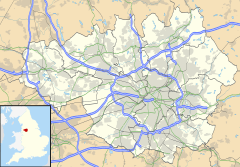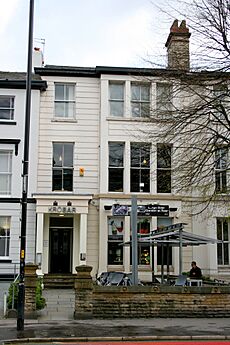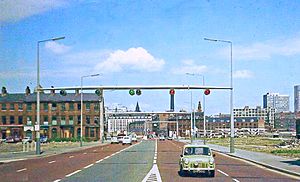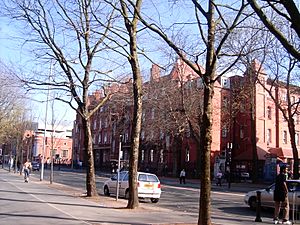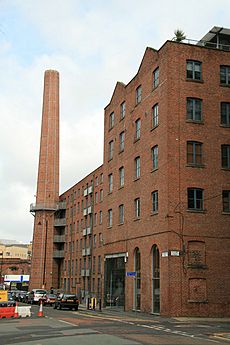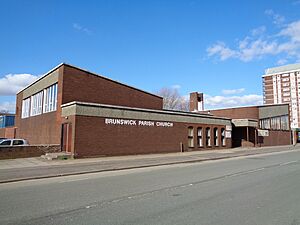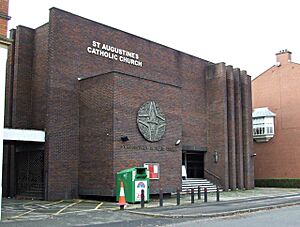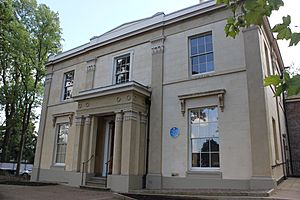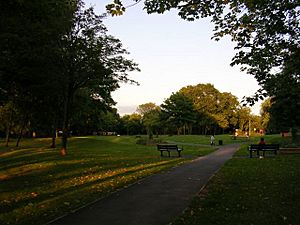Chorlton-on-Medlock facts for kids
Quick facts for kids Chorlton-on-Medlock |
|
|---|---|
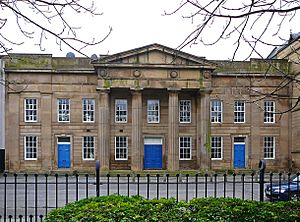 The former Chorlton-on-Medlock Town Hall |
|
| OS grid reference | SJ856967 |
| Metropolitan borough | |
| Metropolitan county | |
| Region | |
| Country | England |
| Sovereign state | United Kingdom |
| Post town | MANCHESTER |
| Postcode district | M12,13 |
| Dialling code | 0161 |
| Police | Greater Manchester |
| Fire | Greater Manchester |
| Ambulance | North West |
| EU Parliament | North West England |
| UK Parliament |
|
Chorlton-on-Medlock is a busy area in Manchester, England. It's located close to the city centre.
This area is bordered by the River Medlock to the north. Other nearby areas include Hulme to the west and Ardwick to the east. To the south, you'll find Victoria Park, Rusholme, and Moss Side. A big part of Chorlton-on-Medlock is home to the campuses of the University of Manchester, Manchester Metropolitan University, and the Royal Northern College of Music. There are also several hospitals here, like Manchester Royal Infirmary, and Whitworth Park.
Contents
A Look Back: History of Chorlton-on-Medlock
Long ago, in medieval times, this area was known as Chorlton Row. It was a small village or 'township' within the larger parish of Manchester.
Towards the end of the 1700s, Chorlton Row started to grow. It became a place where people from Manchester lived, like a suburb. Some cotton mills were built in the northern part of the area. In 1820, the local church, All Saints, was built. New streets were planned in 1793–94, with grand names like Oxford Street and Cambridge Street.
Over the next 30 years, more homes were built, spreading south. By the mid-1840s, development reached High Street. Not many of these old buildings are left today. Some examples include Waterloo Place and Grove House.
In 1838, Chorlton-on-Medlock became part of the growing city of Manchester. At this time, the southern part of the area was still quite rural. Some wealthy people lived in large houses there, like John Owens.
A big change happened in 1873 when Owens College moved here. This was the start of the area becoming a major academic hub, which is what you see today with the universities. Over the years, the college and then the university expanded into the surrounding residential areas. In the early 2000s, the University of Manchester and the city council worked together on a project called Corridor Manchester. This project has greatly changed the look of Oxford Road.
Where is Chorlton-on-Medlock?
The postcode for much of Chorlton-on-Medlock is M13. However, some parts have an M15 postcode, which is usually for Hulme. The River Medlock forms the boundary with Manchester city centre. The city centre includes the "North Campus" of the University of Manchester. A large part of Chorlton-on-Medlock is also taken up by Manchester Metropolitan University.
 |
Hulme | Manchester city centre | Ardwick |  |
| Moss Side | Longsight | |||
| Rusholme | Fallowfield |
Getting Around: Transport
The Mancunian Way, a major elevated road, runs through the northern part of Chorlton-on-Medlock. It opened in 1967. The main roads that go through this area to south Manchester are Cambridge Street, Oxford Road, and Upper Brook Street. Oxford Road is especially busy for both cars and buses.
Important Buildings and Places
You can still see the front of the old Chorlton-on-Medlock Town Hall on Cavendish Street. This building, with its grand columns, was built in 1830–31. The Pankhurst Centre is also in Nelson Street. This was once the home of the Pankhurst family, who were famous for fighting for women's right to vote.
Next to the town hall is the original building of the Manchester College of Art (built 1880–81). Further along Oxford Road, you'll find the University of Manchester (built 1888–1902), the former Manchester Royal Eye Hospital (1886), Manchester Royal Infirmary (1908), and the Whitworth Art Gallery (1898–1908).
Places of Worship
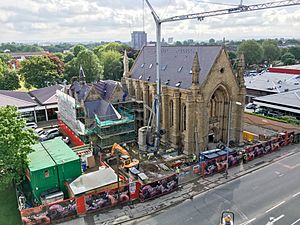
Many old churches in Chorlton-on-Medlock have been demolished. These include the Anglican churches of All Saints (1820) and St Luke. Some other Anglican churches like St Stephen's, St Paul's, and St Ambrose have also been pulled down. St Ambrose was used by the University of Manchester as an Islamic prayer room for some time.
The oldest Roman Catholic church still standing in Chorlton-on-Medlock is the Church of the Holy Name on Oxford Road. It was built between 1869 and 1871. Another Catholic church, St Augustine's, was destroyed by bombing in 1940 during World War II. Its replacement is now on the Manchester Metropolitan University campus.
The Armenian church in Upper Brook Street was the first church built specifically for Armenians in Western Europe. It opened in 1870.
Many other types of churches, called Nonconformist chapels, used to be in the area. Most of these have been demolished. One notable one was the Cavendish Street Congregational Church. The Welsh Baptist Chapel, on Upper Brook Street, was designed by Sir Charles Barry, who also designed the Palace of Westminster.
The Salvation Army has its Manchester I corps at Manchester Temple on Grosvenor Street. It started in 1879, and a modern building stands on the original site.
Today, there are two mosques in Chorlton-on-Medlock: the Salimiya Mosque and the Islamic Academy of Manchester on Upper Brook Street. The Islamic Academy is in the building that used to be the Welsh Baptist Chapel. Both the University of Manchester and Manchester Metropolitan University also have prayer rooms on Oxford Road.
Famous People from Chorlton-on-Medlock
See also List of people from Manchester
Many interesting people have lived or were born in Chorlton-on-Medlock:
- James Braid (1795-1860), a Scottish surgeon who studied hypnosis, lived and died on Oxford Street.
- Friedrich Engels (1820–1895), a German thinker and philosopher, lived here. A plaque marks the spot where he stayed.
- Elizabeth Gaskell, a famous writer, lived in a house at 84, Plymouth Grove for the last 15 years of her life. Her husband, William Gaskell, a minister and writer, also lived there.
- David Lloyd George, who later became a British Prime Minister, was born here in 1863. His family moved back to Wales soon after.
- George Gissing (1857–1903), a writer, lived on Grafton Street when he was a student at Owens College in 1876.
- Lilly Maxwell, the first woman to vote in Britain after the Reform Act 1832, cast her vote at the Chorlton Town Hall in 1868.
- John Owens, a merchant who gave money to start Owens College (which became the University of Manchester), lived on Nelson Street.
- Robert Angus Smith, a Scottish chemist, had his laboratory in Grosvenor Square.
- Lily Elsie, a famous Edwardian actress and singer, spent part of her childhood here.
- Jerome Caminada, a police detective, is thought to have inspired the character of Sherlock Holmes. He lived on Cecil Street.
- Ellen Wilkinson, a Labour Party politician and Cabinet minister, was born here in 1891. She graduated from the University of Manchester.
- Arthur Delaney (1927–1987), an artist, was born on Clifford Street. His art was inspired by the Manchester he remembered from his childhood in the 1930s.
- Emmeline Pankhurst, a leader of the British suffragette movement, lived on Nelson Street after her husband passed away. Her house is now the Pankhurst Centre.
Images for kids


